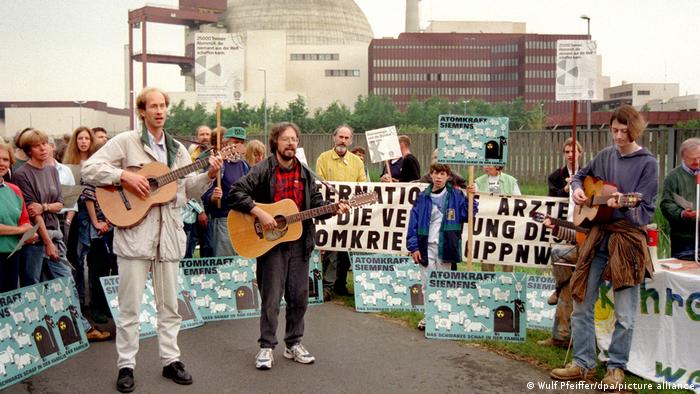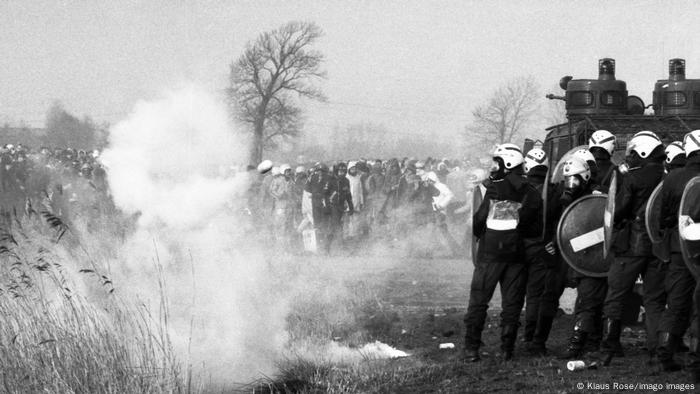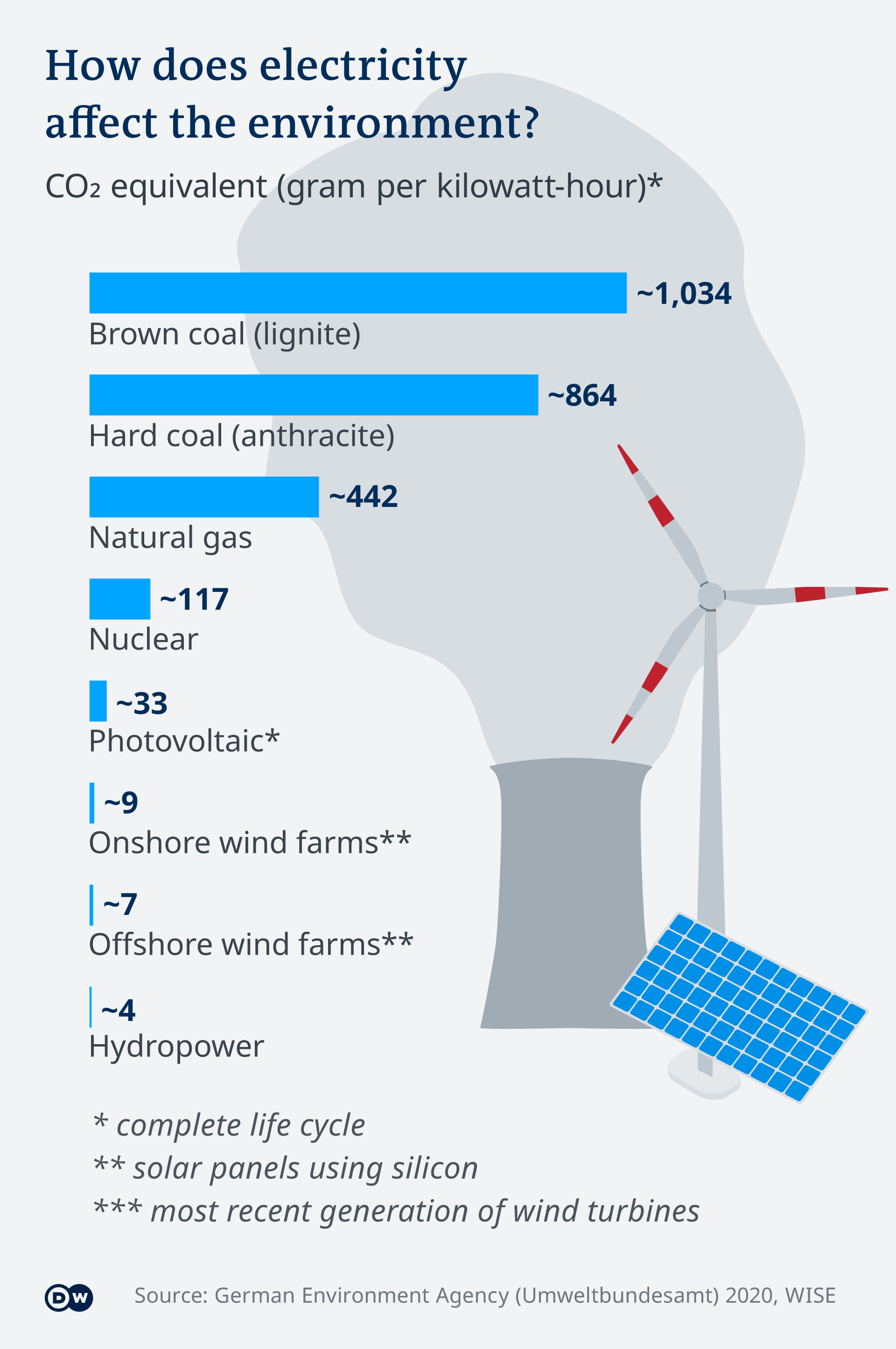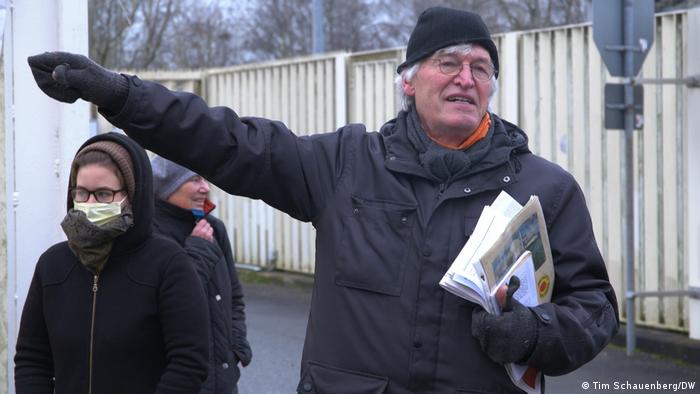Activists have been protesting in front of the nuclear power plant in Brokdorf, northern Germany for 35 years. But now that the plant is set to be removed from the grid, their vigil is finally over.

Protesters have gathered at the Brokdorf nuclear reactor every month since 1986
An icy wind is blowing across the Brokdorf nuclear power plant that stands between damp meadows and a dike covered in a thin layer of snow.
A small group of mostly elderly people have hung up a yellow banner on the guarded gate to the nuclear reactor which reads: "Shut down nuclear power plants."
Gathered on this wintry, gray day in the northernmost state of Schleswig-Holstein, the activists are mostly from the area — though some have come from Hamburg and beyond.
Singing peace songs and chatting while standing in a circle, the groups appear well-adjusted to the freezing cold, having met at the power plant's gate on the sixth day of each month for the last 35 years.
Today, the activists are once again holding a vigil to commemorate the victims of nuclear catastrophes while also demanding the shutdown of the nuclear reactor in their neighborhood.
Today is different, however. This 425th vigil will be the last. Later this month, the Brokdorf nuclear power plant will be shut down as part of Germany's 2022 nuclear phaseout.
The reactor has been both one of Germany's most controversial and one of the world's most productive.
"I'm glad it's being phased out," said Hans-Günter Werner, a pastor and co-founder of the activist initiative. "I'm not sad, but I am a little nostalgic because I know that we won't meet again soon.
"But for the most part, I feel relieved that the operation of the nuclear power plant is finally coming to an end," he added. "At the time, we didn't expect that we would need to stand here for so long."
First nuclear reactor after Chernobyl
Amid the growing anti-nuclear movement in the 1980s, hundreds of thousands protested against the construction of the nuclear plant in Brokdorf.
Time and again, the protesters clashed with the police — especially after the nuclear accident in Chernobyl in 1986 saw increased radiation levels in soil and foods across Germany.
"I had small children who were not allowed to play in the sandbox. We all panicked," said Werner at the sidelines of the vigil.
Opening in late 1986, Brokdorf was the first nuclear reactor in the world to go into operation after the Chernobyl disaster.
At that time, Werner and a few allies protested peacefully and decided to continue their protests in the future. They vowed to meet once a month until Brokdorf was shut down.
He said that "showing opposition" and protesting also "helped us to combat our own fears."

Police clashed with some of the 100,000 anti-nuclear demonstrators marching against the Brokdorf plant in February 1981
Increased cancer risk, and an ice rink
His fears weren't unjustified. In 2008, a study found that children growing up in close proximity to a German nuclear power plant face a higher risk of developing leukemia.
Yet plants stayed open amid such health threats. One reason might be the decades of high revenues earned by the Brokdorf municipality through a commercial tax on the plant. Local politicians were loath to give up this income.
The village, which has no more than 1,000 inhabitants, was able to fund a €7 million ($8 million) ice rink with the nuclear plant tax, and ticket prices for the public swimming pool with a 100 meter water slide were kept extremely low.
"It's a commercial activity in our municipality, and as a municipality we always support our local enterprises," said Brokdorf Mayor Elke Göttsche of the plant.
Göttsche would have preferred that the nuclear facility remain on the grid a while longer, arguing that this would have eased the transition to renewable energy. Now, however, the funding bonanza from the nuclear reactor is no more.
Nuclear power claims climate credentials
While Germany is phasing out all its remaining nuclear plants by the end of 2022, other countries like France, the United Kingdom, the United States, India, Russia and China continue to rely on nuclear energy.
Globally, around 440 nuclear reactors are still operating, providing around 10% of the global energy supply. Some 50 nuclear reactors were under construction this year, 18 of which are being built in China.
Three hundred more nuclear plants are currently in the planning phase. Meanwhile, the nuclear power lobby is promoting nuclear energy as an allegedly clean and, most importantly, climate-friendly alternative.
French President Emanuel Macron even announced this year that in order to achieve climate neutrality by 2050, France would restart plans to build new smaller nuclear plants for the first time in decades.
Emissions from nuclear energy are significantly lower than those from coal, oil and natural gas.
Yet, compared to power from wind and solar energy, the technology costs are much higher, and the construction of nuclear plants takes significantly longer.

Military motives
The fact that states still stick with nuclear power clearly also has another reason, said Andrew Stirling, professor of science and technology policy at the University of Sussex.
"Globally speaking, those countries that are the most truly dedicated to a civil use of nuclear energy either also have nuclear weapons or they are very keen on getting them," he said.
According to Stirling, the civil use of nuclear energy is often needed for the realization of nuclear weapons programs, a point admitted by nuclear armed France and the US.
Without the engineers and specialists working in the commercial nuclear power sector, it would be impossible to build nuclear-powered submarines, for example, Stirling explained.
"The reports from the USA are absolutely clear. Even if the costs of nuclear energy were twice as high, it would still make sense for them to build reactors because this allows them to keep up their military activities," he said.
Last vigil
Sharing coffee, cake and pumpkin soup, the Brokdorf activists look back together on 35 years of protests.
Photo collages are rolled out, including images from private photo albums.
Yet although Brokdorf will be removed from the grid on December 31, the plant will continue to serve as a temporary storage facility for nuclear waste for decades. There is still no final repository for radioactive waste.
"Therefore, our commitment is not yet over," said one of the activists. Shortly after, someone starts playing the guitar.
The protesters leave the Brokdorf plant singing. For the first time in 35 years, they're also leaving as winners.
The fact that states still stick with nuclear power clearly also has another reason, said Andrew Stirling, professor of science and technology policy at the University of Sussex.
"Globally speaking, those countries that are the most truly dedicated to a civil use of nuclear energy either also have nuclear weapons or they are very keen on getting them," he said.
According to Stirling, the civil use of nuclear energy is often needed for the realization of nuclear weapons programs, a point admitted by nuclear armed France and the US.
Without the engineers and specialists working in the commercial nuclear power sector, it would be impossible to build nuclear-powered submarines, for example, Stirling explained.
"The reports from the USA are absolutely clear. Even if the costs of nuclear energy were twice as high, it would still make sense for them to build reactors because this allows them to keep up their military activities," he said.
Last vigil
Sharing coffee, cake and pumpkin soup, the Brokdorf activists look back together on 35 years of protests.
Photo collages are rolled out, including images from private photo albums.
Yet although Brokdorf will be removed from the grid on December 31, the plant will continue to serve as a temporary storage facility for nuclear waste for decades. There is still no final repository for radioactive waste.
"Therefore, our commitment is not yet over," said one of the activists. Shortly after, someone starts playing the guitar.
The protesters leave the Brokdorf plant singing. For the first time in 35 years, they're also leaving as winners.

No comments:
Post a Comment